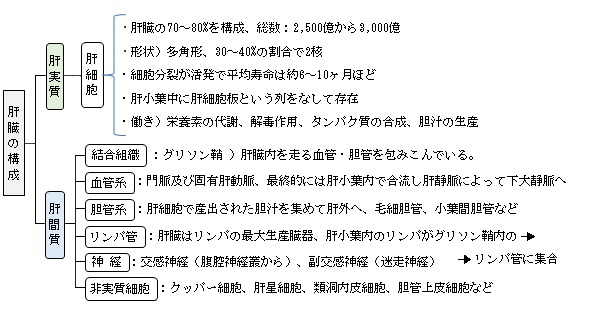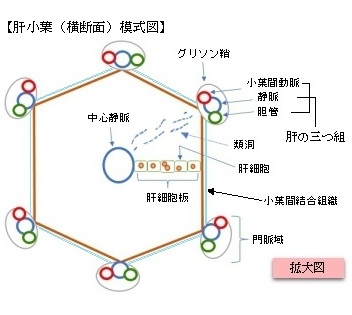
・肝臓は肝実質と肝間質に分けられるが、肝実質を構成要素となるのがこの肝細胞である。



・「(肝臓が)完全に新しく生まれ変わるまでに1〜2年かかるともいわれてい」(ChatGPT)


【働 き】
1. 代 謝
食べ物から吸収された栄養(糖・脂肪・タンパク質)を処理・貯蔵・変換します。
変換:ブドウ糖をグリコーゲンに変換して貯蔵
2. 解 毒
体にとって有害物質(アルコール、薬、アンモニアなど)を分解・無毒化する。
3. 胆汁の生成
コレステロールやビリルビン(ヘモグロビンの分解産物)などから胆汁を生成して胆嚢に輸送する。
4. 血液中の成分の合成
アルブミン(血中タンパク質)や血液凝固因子を合成している。
【その他の細胞】
肝臓を構成する細胞のメインは肝細胞となるが、その他として以下のような構成要素として挙げられる。
| |
名 称 |
解 説 |
1 |
クッパー細胞 |
肝臓の免疫細胞として異物、細菌、老廃赤血球の貪食処理を行う。
数:肝臓全体の15%前後(by ChatGPT)
|
2 |
肝星細胞 |
|
3 |
類洞内皮細胞 |
類洞を構成する細胞で、一般的な内皮細胞(endothelial cell)とは異なり連続しておらず多数の 小孔(fenestration)が見られる。 |
4 |
胆管上皮細胞 |
胆管壁を構成する細胞 |
5 |
その他 |
免疫細胞(T細胞、NK細胞など)、肝前駆細胞、線維芽細胞様細胞、血管内皮細胞(門脈、肝動脈など) |
【参考となるサイト】
以下は「Wikipedia」の解説文となる。
A hepatocyte is a cell of the main parenchymal tissue of the liver. Hepatocytes make up 80% of the liver's mass. These cells are involved in:
【Structure】
The typical hepatocyte is cubical with sides of 20-30 μm, (in comparison, a human hair has a diameter of 17 to 180 μm).[1] The typical volume of a hepatocyte is 3.4 x 10−9 cm3.[2] Smooth endoplasmic reticulum is abundant in hepatocytes, in contrast to most other cell types.[3]
【Microanatomy】
Hepatocytes display an eosinophilic cytoplasm, reflecting numerous mitochondria, and basophilic stippling due to large amounts of rough endoplasmic reticulum and free ribosomes. Brown lipofuscin granules are also observed (with increasing age) together with irregular unstained areas of cytoplasm; these correspond to cytoplasmic glycogen and lipid stores removed during histological preparation. The average life span of the hepatocyte is 5 months; they are able to regenerate.[citation needed]
Hepatocyte nuclei are round with dispersed chromatin and prominent nucleoli. Anisokaryosis (or variation in the size of the nuclei) is common and often reflects tetraploidy and other degrees of polyploidy, a normal feature of 30-40% of hepatocytes in the adult human liver.[4] Binucleate cells are also common.[citation needed]
Hepatocytes are organised into plates separated by vascular channels (sinusoids), an arrangement supported by a reticulin (collagen type III) network. The hepatocyte plates are one cell thick in mammals and two cells thick in the chicken. Sinusoids display a discontinuous, fenestrated endothelial cell lining. The endothelial cells have no basement membrane and are separated from the hepatocytes by the space of Disse, which drains lymph into the portal tract lymphatics.[citation needed]
Kupffer cells are scattered between endothelial cells; they are part of the reticuloendothelial system and phagocytose spent erythrocytes. Stellate (Ito) cells store vitamin A and produce extracellular matrix and collagen; they are also distributed amongst endothelial cells but are difficult to visualise by light microscopy.[citation needed]
【Function】
【Protein synthesis】
The hepatocyte is a cell in the body that manufactures serum albumin, fibrinogen, and the prothrombin group of clotting factors (except for Factors 3 and 4).[citation needed]
It is the main site for the synthesis of lipoproteins, ceruloplasmin, transferrin, complement, and glycoproteins. Hepatocytes manufacture their own structural proteins and intracellular enzymes.[citation needed]
Synthesis of proteins is by the rough endoplasmic reticulum (RER), and both the rough and smooth endoplasmic reticulum (SER) are involved in secretion of the proteins formed.[citation needed]
The endoplasmic reticulum (ER) is involved in conjugation of proteins to lipid and carbohydrate moieties synthesized by, or modified within, the hepatocytes.[citation needed]
Proteins produced by hepatocytes that function as hormones are known as hepatokines.[citation needed]
【Carbohydrate metabolism】
See also: Lipogenesis
The liver forms fatty acids from carbohydrates and synthesizes triglycerides from fatty acids and glycerol.[5] Hepatocytes also synthesize apoproteins with which they then assemble and export lipoproteins (VLDL, HDL).[citation needed]
The liver is also the main site in the body for gluconeogenesis, the formation of carbohydrates from precursors such as alanine, glycerol, and oxaloacetate.[citation needed]
【Lipid metabolism】
The liver receives many lipids from the systemic circulation and metabolizes chylomicron remnants. It also synthesizes cholesterol from acetate and further synthesizes bile salts. The liver is the sole site of bile salts formation.[citation needed]
【Detoxification】
Hepatocytes have the ability to metabolize, detoxify, and inactivate exogenous compounds such as drugs (see drug metabolism), insecticides, and endogenous compounds such as steroids.[citation needed]
The drainage of the intestinal venous blood into the liver requires efficient detoxification of miscellaneous absorbed substances to maintain homeostasis and protect the body against ingested toxins.[citation needed]
One of the detoxifying functions of hepatocytes is to modify ammonia into urea for excretion.[citation needed]
The most abundant organelle in liver cells is the smooth endoplasmic reticulum.[citation needed]
【Aging】
As mammalian liver cells age, damages in their DNA increase in prevalence. A review of the literature indicated that in mouse liver cells DNA damages (single-strand breaks, oxidized bases and 7-methylguanine) increase with age.[6] Also, in rat liver, DNA single- and double-strand breaks, oxidized bases, and methylated bases increase with age; and in rabbit liver, cross-linked bases increase with age.[6] Liver cells depend on DNA repair pathways that specifically protect the transcribed compartment of the genome to promote sustained functionality and cell preservation with age.[7]
【 語 句 】
・: ・: ・: ・: ・: ・: ・: ・: ・: ・: ・: ・: ・: ・: ・: ・: ・: ・: ・: ・: ・: ・: ・: ・: ・: ・: ・: ・: ・: ・: ・: ・:
■ 写真やイラストを掲載しているサイト ■
・ イラストや写真を掲載しているサイト-Ⅰ
・ イラストや写真を掲載しているサイト-Ⅱ
・ イラストや写真を掲載しているサイト-Ⅲ
